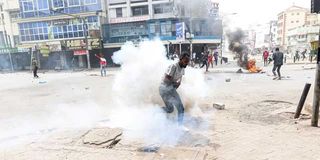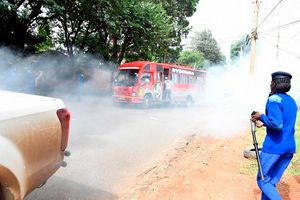Teargas pollution: Kenyans worry over headaches, eye pain, and effect on pregnancy

A tear gas canister is fired at anti-government protesters on Tom Mboya Street in Nairobi on July 2, 2024.
What you need to know:
- Doctors say tear gas can cause spontaneous abortions, commonly known as miscarriage.
Air pollution accounts for over 8.1 million deaths globally.
When Maria Gorretti, a 19-year-old, joined the Finance Bill 2024 protests on Tuesday June 26, she knew she would have to be careful because she was asthmatic.
She woke up early to join her peers, and together, they made their way to the city centre, carrying placards, whistles, masks and water. Maria had something else that other protestors did not have, an inhaler, a medical device used by asthmatics like her.
The protest was going well until police suddenly threw a tear gas canister at them.
“I could not see anything, let alone breathe, and shortly I felt so dizzy,” she says.
Her three friends came to her rescue, but as they tried to lift her up, another officer fired yet another tear gas canister directly at them.
At this point, Maria was choking on endless bouts of acrid smoke.
“I struggled to find my inhaler because my chest had started becoming so heavy, and my friends put me on a boda boda and then rushed me to hospital. That’s all I remember before I passed out,” she tells Lifestyle.
The 19-year-old would come to five hours later. It is then that she learned she was also pregnant. She wonders whether the tear gas has harmed her baby.
Spontaneous miscarriages
The protests have left an aftermath of death, injury and destruction of property, but one factor that has not been discussed much is the effect of tear gas on one’s health. Tear gas is made from highly toxic liquefied chemicals, and is harmful to the respiratory system, skin, eyes, and even a foetus.
Days after the protests, a number of Kenyans are now complaining of headaches, a dry throat and skin, and eye pain, forcing them to wear masks as tear gas remnants pollute the city and its outskirts.
Doctors say tear gas can cause spontaneous abortions, commonly known as miscarriage, and other short and long-term adverse health outcomes, including blindness, glaucoma, and respiratory failure. The tear gas causes eye irritation to the eyes, mouth, throat, lungs, and skin too.
Headaches
Stephen Lang’at, 21, who participated in the protests, is one of the people complaining of persistent headaches.
He says his eyes have also been tearing endlessly after exposure to tear gas, and now they are very sensitive to light even though he wears eyeglasses.
“I visited an ophthalmologist yesterday who has told me to go back for more tests tomorrow. She said that high concentrations of chemicals in tear gas may cause corneal damage, opacity, and permanent visual impairment, this is why she needs to examine me thoroughly,” Stephen, a university student, says.
According to Dr Abhijit Rasal, an ophthalmologist at Lions FirstSight Eye Hospital in Nairobi, once someone is exposed to tear gas, one will begin to notice symptoms after 20 to 30 seconds.
“Once someone (breathes in the tear gas) physical exertion, such as running, makes them more susceptible to severe symptoms. In that case, it is difficult to breathe, which could lead to violent coughing, some can even start coughing blood,” he said.
Though the symptoms appear to be temporary, lasting only 20 to 30 minutes, if you are exposed to the gas for a longer duration or are not able to breathe fresh air, you might face long-term effects and other health-related issues, says the ophthalmologist.
Dr Rasal says that these include corneal abrasion (a superficial scratch of the cornea), red eyes, chronic skin reactions, chemical burns, as well as lung injury.
So what should you do when tear gas gets in your eyes?
First, thoroughly flush the eyes with water or saline, ensure no particles remain in the eye, he says.
When it comes to your skin, flush with copious amounts of water and soap, or a mildly alkaline solution (sodium bicarbonate or sodium carbonate).
Decontamination is unnecessary if the wind is brisk, as such, particles may be shaken off clothing and hair.
It is, however, important to note that when the oleoresin capsicum (OC) is used as an anti-riot agent, the pain will increase with water.
“In this case, it is best to decontaminate with baby shampoo, milk (which contains casein), alcohol, or vegetable oil,” the National Center for Biotechnology Information recommends.
“With decontamination, the pain will subside over time,” Dr Rasal assures.
He also notes that blunt trauma from canister injuries to the head may damage the eyes, apart from causing neurological irritability.
Nairobi air quality during protests
The tear gas also caused air pollution, and many Kenyans in Nairobi’s Central Business District have had to start wearing masks.
Professor Nicholas Oguge from the Centre for Advanced Studies in Environmental Law and Policy at the University of Nairobi warns that the amount of air pollution in the last two weeks brought about by the toxic effects of tear gas, gunshot fumes, burning cars and tyres, as well as destruction of buildings coated with paints, have contributed to the emission of hazardous chemicals and heavy metals in the air. These will result in long-term respiratory illnesses.
The latest data from the University of Nairobi air quality sensors showed that in the last two weeks, at a PM 2.5 levels, the levels were above the World Health Organisation (WHO) recommended air quality guideline. (A levels for a 24-hour average exposure of 15 g/m 3.
Prof Oguge said nitrogen dioxide (NO2), a gaseous air pollutant that is mainly generated through the burning of fuel in cars, explosives, power plants, and industrial facilities was largely within the WHO-recommended concentration of 25 g/m 3 before the protests started.
“This was marginally exceeded on three occasions of 18/06/2024 (26 g/m 3), 22/06/2024 (31 g/m 3), and 25/06/2024 (26 g/m 3),” he highlighted, adding that short-term exposure to NO2 can irritate the airways and aggravate existing respiratory diseases.
“For people with asthma, NO2 exposure is associated with more frequent and severe asthma symptoms and a greater risk of hospitalisation,” he adds.
Air pollution accounts for over 8.1 million deaths globally.
“Thirty percent of deaths from lower respiratory infections, 28 percent of deaths from ischemic heart disease and 48 percent of deaths from chronic obstructive pulmonary disease,” he explained, adding that in Kenya, there will be a need to investigate hospital data in case of increased hospitalisation from such spikes for respiratory and cardiovascular disease burdens during the protest period.
Back to World War I
Chemical agents have been used for centuries. In 2300 BCE, before World War I (WWI), Chinese armies used “stink pots” during wars.
They burned red peppers in hot oil to produce offensive smoke and burden their opposition before the attack. Japanese fighters ground peppers to fine dust and wrapped the dust in rice paper to throw into the faces of their opponents.
Also, wood saturated with pitch and sulfur was burned to create offensive smoke in the Peloponnesian wars.
But several chemicals were weaponised during WWI and France was the first to use gas, in August 1914.
Companies like Dupont Chemical began to produce gas and market it to police departments and prisons for riot control.
Apart from the tear gas, the protestors were dispersed by water cannons, which shoot foam, tear gas, and dye which comes in various colours such as orange, pink and red to ‘mark’ protesters as the dye cannot easily come off their clothes.





